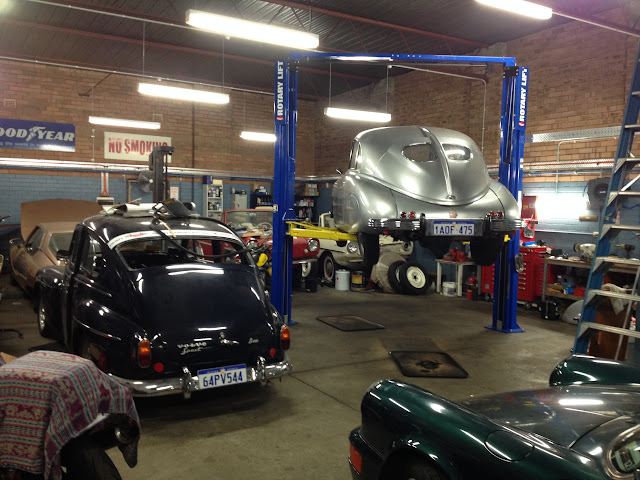When I bought the Tatra in 2015 it was in full knowledge that the car had problems and needed a bit of work to get back on the road. Shannon's auction report had quite openly stated "the engine needs work and lacks power." That was something of an understatement. An engine diagnostics test showed that cylinder number two did not fire at ignition but only came online once the engine warmed up. The ignition timing was also way, way off.

I drove the car a couple of times - mainly back and forth to a mechanic's shop - before the engine gave up the ghost, ironically while I was driving the car to my brother-in-law's place to put it in storage. It made the last kilometre of the trip on the back of a truck.
Finding a mechanic willing to take a look at the car took about six months. Rhys and Wayne of Classic Gasoline appreciated the opportunity to work on something that was unusual. I expected that major issues would be uncovered, but the problems weren't as serious as I'd feared. The issues all stem from the car spending two decades as a museum piece. Although it was maintained, it didn't really get driven any distance. Lack of regular use meant items like the brakes, carburetor and engine tune began to fail. When repaired, they were repaired 'just enough.' The car ran and could be moved about under its own power, but that was about all.
The first task the guys looked at was the engine timing. The distributor had been rebuilt at some time in the past - very badly. The contact points were wrong and badly set and needed replacing. The original PAL points were not longer available so a modern Bosch set was customized to fit. The difference that made to the engine was incredible.
Next was the carburetors. The carbs are a Solex 32 PBIC. Both carbs have been repaired in the past with incorrect parts, meaning they were feeding the engine unevenly. A carb repair kit was used, plus two donated Solex's from a Renault 10 were cannibalized to effect repairs.
Despite two previous adjustments to the brakes, they were still seizing, so the brake system was drained and the fluid examined in detail. At least three different fluids, one being castor oil (which appears to be in line with original specs) were present in the system, so clearly no had actually flushed the brakes during it's most recent service history.
The brake dragging effect was found to be caused by the de-lamination of the original, asbestos brake pads. New brake linings have been fitted.
All six tyres were also replaced. The size is rather odd being 600x16, which I was able to source from Antique Tyres (https://antiquetyres.com.au/). Officially these were described as tractor tyres!
Although there were still quite a few issues to resolve, this was enough for me at that time. I had no intention of driving the car often and these fixes were sufficient for the car to be driveable and enjoyable.
A big thanks goes out to Rhys, Wayne and Brendan of Classic Gasoline for their efforts getting her running again (love the Amphicars by the way).
https://www.facebook.com/Classic-Gasolene-294822500701143/timeline/
And here is a video of my first test drive after picking up the car.
A history of the pioneering Czech automobile manufacturer and it's amazing streamlined cars.
Friday, 18 September 2020
More Tatra Repairs
Subscribe to:
Post Comments (Atom)








No comments:
Post a Comment